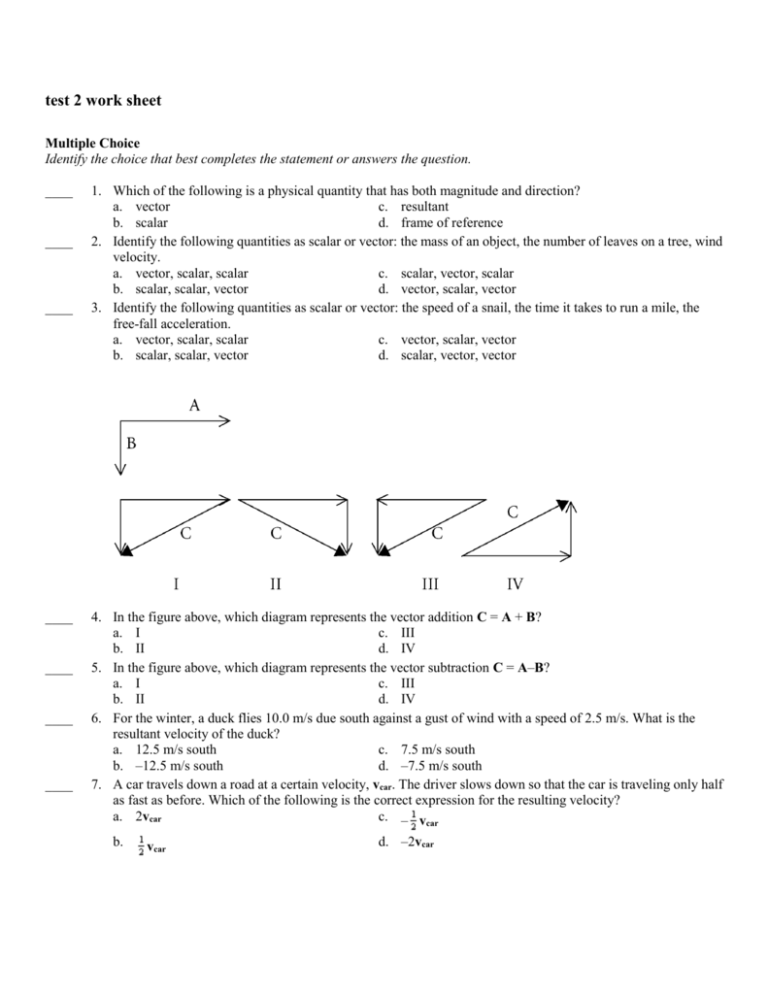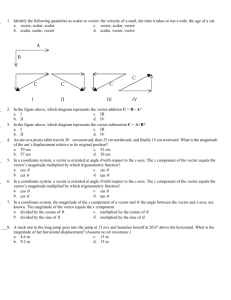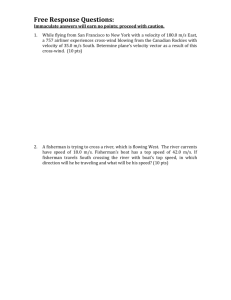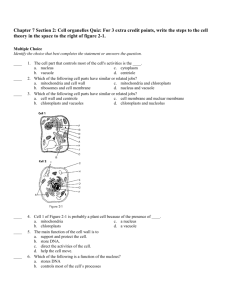worksheet for 2 test
advertisement

test 2 work sheet Multiple Choice Identify the choice that best completes the statement or answers the question. ____ ____ ____ ____ ____ ____ ____ 1. Which of the following is a physical quantity that has both magnitude and direction? a. vector c. resultant b. scalar d. frame of reference 2. Identify the following quantities as scalar or vector: the mass of an object, the number of leaves on a tree, wind velocity. a. vector, scalar, scalar c. scalar, vector, scalar b. scalar, scalar, vector d. vector, scalar, vector 3. Identify the following quantities as scalar or vector: the speed of a snail, the time it takes to run a mile, the free-fall acceleration. a. vector, scalar, scalar c. vector, scalar, vector b. scalar, scalar, vector d. scalar, vector, vector 4. In the figure above, which diagram represents the vector addition C = A + B? a. I c. III b. II d. IV 5. In the figure above, which diagram represents the vector subtraction C = A–B? a. I c. III b. II d. IV 6. For the winter, a duck flies 10.0 m/s due south against a gust of wind with a speed of 2.5 m/s. What is the resultant velocity of the duck? a. 12.5 m/s south c. 7.5 m/s south b. –12.5 m/s south d. –7.5 m/s south 7. A car travels down a road at a certain velocity, vcar. The driver slows down so that the car is traveling only half as fast as before. Which of the following is the correct expression for the resulting velocity? a. 2vcar c. – vcar b. vcar d. –2vcar ____ ____ 8. A football player runs in one direction to catch a pass, then turns and runs twice as fast in the opposite direction toward the goal line. Which of the following is a correct expression for the original velocity and the resulting velocity? a. –vplayer, –2vplayer c. vplayer, –2vplayer b. vplayer, 2vplayer d. 2vplayer, –vplayer 9. A student walks from the door of the house to the end of the driveway and realizes that he missed the bus. The student runs back to the house, traveling three times as fast. Which of the following is the correct expression for the return velocity if the initial velocity is vstudent? a. 3vstudent c. vstudent b. d. –3vstudent vstudent ____ 10. Which of the following is the best coordinate system to analyze a painter climbing a ladder at an angle of 60° to the ground? a. x-axis: horizontal along the ground; y-axis: along the ladder b. x-axis: along the ladder; y-axis: horizontal along the ground c. x-axis: horizontal along the ground; y-axis: up and down d. x-axis: along the ladder; y-axis: up and down ____ 11. An ant on a picnic table travels 30 cm eastward, then 25 cm northward, and finally 15 cm westward. What is the magnitude of the ant’s displacement relative to its original position? a. 70 cm c. 52 cm b. 57 cm d. 29 cm ____ 12. In a coordinate system, a vector is oriented at angle with respect to the x-axis. The x component of the vector equals the vector’s magnitude multiplied by which trigonometric function? a. cos c. sin b. cot d. tan ____ 13. In a coordinate system, a vector is oriented at angle with respect to the x-axis. The y component of the vector equals the vector’s magnitude multiplied by which trigonometric function? a. cos c. sin b. cot d. tan ____ 14. How many displacement vectors shown in the figure above have horizontal components? a. 2 c. 4 b. 3 d. 5 ____ 15. How many displacement vectors shown in the figure above have components that lie along the y-axis and are pointed in the –y direction? a. 0 c. 3 b. 2 d. 5 ____ 16. Which displacement vectors shown in the figure above have vertical components that are equal? a. d and d c. d and d b. d and d d. d and d ____ 17. In a coordinate system, the magnitude of the x component of a vector and , the angle between the vector and x-axis, are known. The magnitude of the vector equals the x component a. divided by the cosine of c. multiplied by the cosine of b. divided by the sine of d. multiplied by the sine of ____ 18. Find the resultant of these two vectors: 2.00 10 units due east and 4.00 10 units 30.0 north of west. a. 300 units, 29.8 north of west c. 546 units, 59.3 north of west b. 581 units, 20.1 north of east d. 248 units, 53.9 north of west The figure above shows the path of a ball tossed from a building. Air resistance is ignored. ____ 19. At what point of the ball’s path shown in the figure above is the vertical component of the ball’s velocity zero? a. A c. C b. B d. D ____ 20. In the figure above, the magnitude of the ball’s velocity is least at location a. A. c. C. b. B. d. D. ____ 21. In the figure above, the magnitude of the ball’s velocity is greatest at location a. A. c. C. b. B. d. D. ____ 22. In the figure above, the horizontal component of the ball’s velocity at A is a. zero. b. equal to the vertical component of the ball’s velocity at C. c. equal in magnitude but opposite in direction to the horizontal component of the ball’s velocity at D. d. equal to the horizontal component of its initial velocity. ____ 23. In the figure above, at which point is the ball’s speed about equal to the speed at which it was tossed? a. A c. C b. B d. D ____ 24. A track star in the long jump goes into the jump at 12 m/s and launches herself at 20.0° above the horizontal. What is the magnitude of her horizontal displacement? (Assume no air resistance and that a = –g = –9.81 m/s .) a. 4.6 m c. 13 m b. 9.2 m d. 15 m ____ 25. Which of the following is a coordinate system for specifying the precise location of objects in space? a. x-axis c. frame of reference b. y-axis d. diagram ____ 26. A passenger on a bus moving east sees a man standing on a curb. From the passenger’s perspective, the man appears to a. stand still. b. move west at a speed that is less than the bus’s speed. c. move west at a speed that is equal to the bus’s speed. d. move east at a speed that is equal to the bus’s speed. ____ 27. A jet moving at 500.0 km/h due east is in a region where the wind is moving at 120.0 km/h in a direction 30.00 north of east. What is the speed of the aircraft relative to the ground? a. 620.2 km/h c. 588.7 km/h b. 606.9 km/h d. 511.3 km/h test 2 work sheet Answer Section MULTIPLE CHOICE 1. 2. 3. 4. 5. 6. ANS: A ANS: B ANS: B ANS: B ANS: D ANS: C Given v = 10.0 m/s south v = 2.5 m/s north PTS: PTS: PTS: PTS: PTS: 1 1 1 1 1 DIF: DIF: DIF: DIF: DIF: I II II I I OBJ: OBJ: OBJ: OBJ: OBJ: 3-1.1 3-1.1 3-1.1 3-1.2 3-1.2 DIF: PTS: PTS: PTS: PTS: IIIA 1 1 1 1 OBJ: DIF: DIF: DIF: DIF: 3-1.2 II II II I OBJ: OBJ: OBJ: OBJ: 3-1.3 3-1.3 3-1.3 3-2.1 DIF: PTS: PTS: PTS: PTS: PTS: IIIA 1 1 1 1 1 OBJ: DIF: DIF: DIF: DIF: DIF: 3-2.2 I I I I I OBJ: OBJ: OBJ: OBJ: OBJ: 3-2.3 3-2.3 3-2.3 3-2.3 3-2.3 Solution vR 7. 8. 9. 10. 11. PTS: 1 ANS: B ANS: C ANS: D ANS: C ANS: D Given x = 3.0 10 y = 25 cm x = –15 cm cm Solution 12. 13. 14. 15. 16. PTS: ANS: ANS: ANS: ANS: ANS: 1 A C C B B 17. ANS: A 18. ANS: D Given d = 2.00 10 d = 4.00 10 PTS: 1 DIF: II OBJ: 3-2.3 units east units 30.0 north of west Solution Measuring direction with respect to x = (east), 19. 20. 21. 22. 23. 24. PTS: 1 DIF: IIIB ANS: B PTS: 1 ANS: B PTS: 1 ANS: D PTS: 1 ANS: D PTS: 1 ANS: C PTS: 1 ANS: B Given vi = 12 m/s at 20.0° above the horizontal Solution OBJ: DIF: DIF: DIF: DIF: DIF: 3-2.4 I II II II II OBJ: OBJ: OBJ: OBJ: OBJ: 3-3.2 3-3.2 3-3.2 3-3.2 3-3.2 PTS: 1 DIF: IIIC OBJ: 3-3.3 25. ANS: C PTS: 1 DIF: I OBJ: 3-4.1 26. ANS: C PTS: 1 DIF: I OBJ: 3-4.1 27. ANS: B Given vpa = velocity of plane relative to the air = 500.0 km/h east vag = velocity of air relative to the ground = 120.0 km/h 30.00° north of east Solution PTS: 1 DIF: IIIB OBJ: 3-4.2








